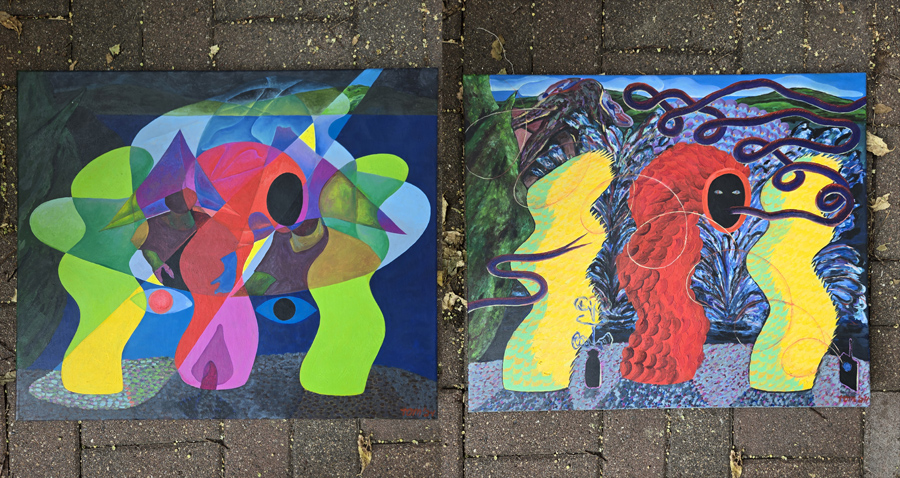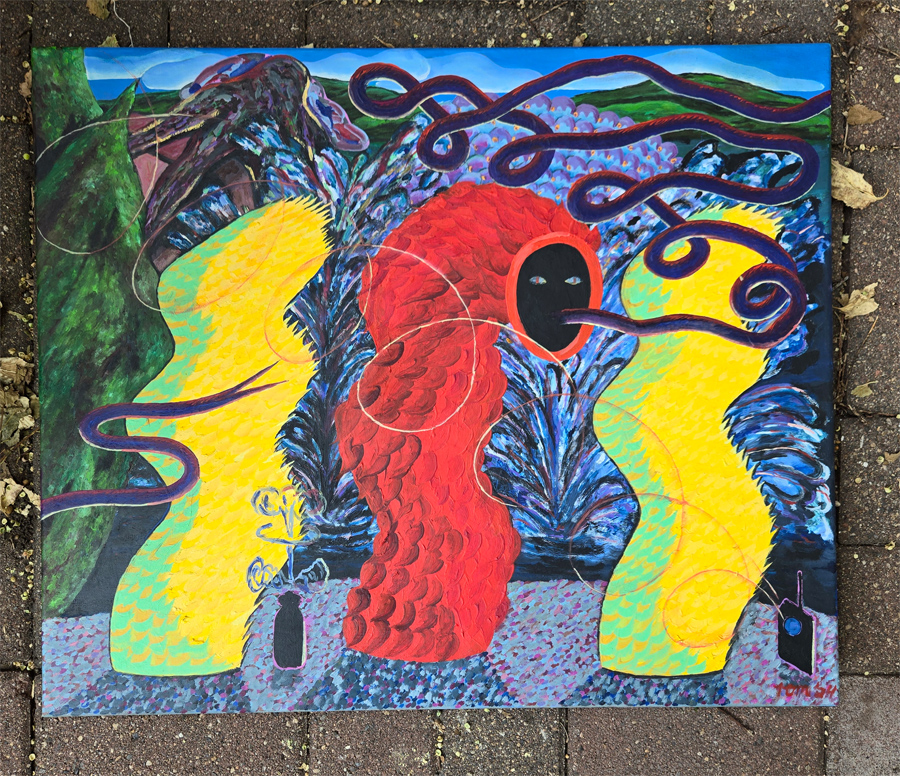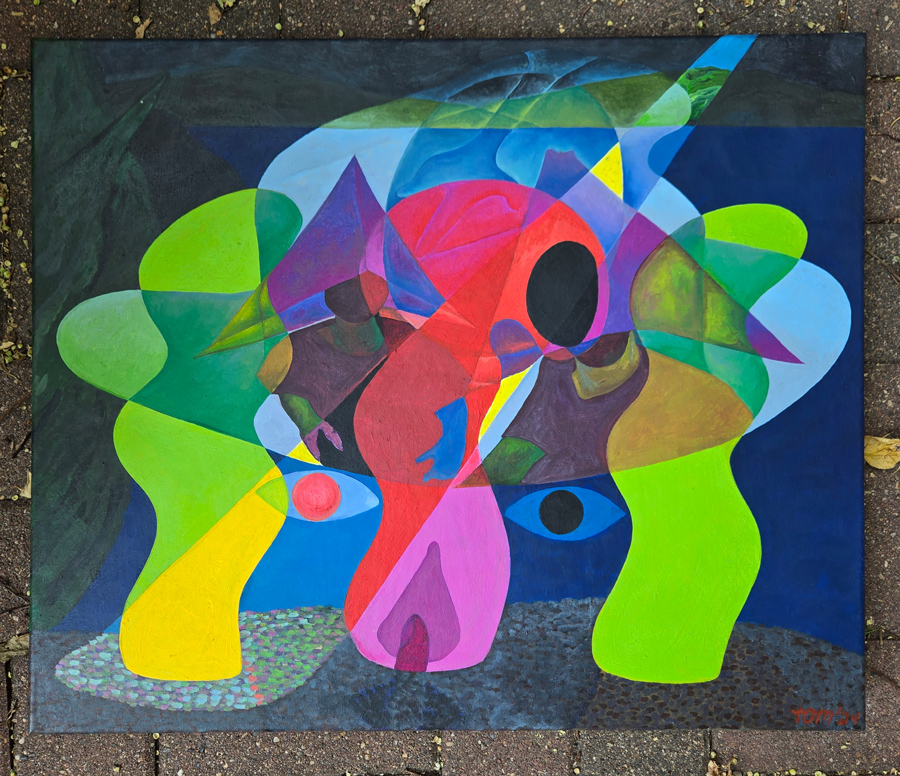Tom Bubul .info
tom.bubul@gmail.com, @tombubul. Last modified .

Dry Hydrant versions (for Dexter & Misha)
During the five summers of 2007 thru '11 I worked at a summer camp that lived primarily on the site of an old boy scout property in Strafford, NH. Its program took place in the front of the property, between two small ponds, where existing scout buildings in decent shape housed (or were readily rehabbed to house) the camp's small but highly active program. New cabins were built on a hill close to this front concentration of buildings for the campers to sleep in. In order for this new construction to meet safety certification requirements, a fire lane had to be cleared on the hill's rear. At the bottom, the camp service road was widened, and a dry hydrant was installed, so that a fire truck could hypothetically utilize the larger of the two ponds in the event of a cabin village inferno, and then accomplish a k-turn. Two yellow concrete bollards were installed to flank the emergency-red dry hydrant as a measure against fire trucks bumping it during such maneuvers. My initial read of the dry hydrant was that it was an absurd injection of the stupefying rules of the outer world in a place largely untouched by them, as aesthetically voided and distinct from the surrounding environment as a blast crater.
Over time the dry hydrant also took on a portal aspect. "Getting everyone to the next station of the day" was a continuous camp consideration, and effectively, the dry hydrant was as far as campers could reasonably get on the boy scout property's footprint to accomplish something in a given hour of programming, factoring in the 10 minutes to walk there and back with a group that often included at least one eight or nine year old. Everything beyond the dry hydrant was "back-camp."
In back-camp, buildings were in generally worse shape and had a lower degree of usage given the commute (the notable exception being Allen's video studio). A treehouse complex built in back-camp in 2008 was essentially never visited in subsequent years; a natural amphitheater for campfires was abandoned in favor of a built solution in front. Once per session, campers camped in tents in back-camp, behind the small pond, near the bottom of service roads leading up a low mountain. The three-quarter mile walk back from these campouts the following mornings, invariably after zero sleep for anyone, was brutal and psychedelic; passing the dry hydrant signaled a return to the world.
I roomed in a building a minute's walk beyond the dry hydrant. In the mornings those summers I walked past it on the gravel road to check in at the camp office before the start of the day. At night, I walked back past it in the dark, and its smooth silhouette before the lake had a different character entirely. Two characters, or one? Observing the days, taking it all in, changing with the light, always the same but different... "I just walked past this thing." ... "How many more times am I gonna walk past this thing."
I think these thoughts in the summer of 2011, then thirteen years pass. In the meantime, the sun has continued to rise and set over the dry hydrant every day. Sometimes mist on the pond in the morning, sometimes the moon passing overhead at night. In that time too, a phantom fire truck has been attempting a k-turn there, now in countless points; periodically the rhythmic bleats of its backup warning system have bounced off the pond in such a way that I've heard them in the distance, wherever I am.
"Stupefying rules of reality" and "blueprint for my utopia" collide at the dry hydrant; I can feel the force of this tension vibrating even now. Over the years my studio, professional work, and friends have continuously pushed me back and forth across this boundary. For this reason, I think, the dry hydrant has become the most resonant image of these years in my memory.
These two paintings were made for old campers and were shipped to NYC and LA, where these campers live in 2024. I knew these guys when they were boys, now they're as old as I was when my dry hydrant era was ending, and I'm middle-aged. The day painting, "Dry hydrant (yeti rock 535 version)" depicts two humongous cannonball splashes in the camp's larger pond, behind the dry hydrant, as Allen's yeti looks out from its home position behind. In front of the hydrant and bollards are a misplaced water bottle and a walkie talkie somebody put down at some point, blasting something urgent out to nobody. This painting aims to embed the hectic/slightly dangerous/saturnalian/lurid texture of daytime camp. "There's a lot going on."
The night painting "Dry hydrant (back-camp shh! version)" depicts the two campers as young children in a UFO landing on the pond, behind the dry hydrant, while a translucent figure in the dark in the close foreground does the "shh!" gesture, and a beam of light cuts across from above to light the left bollard (maybe to beam up a lost water bottle). This one aims to embed the smooth luxurious clean calm of 100 people asleep nearby, walking quietly down the road at night with no flashlight, looking out over the black water of the silent pond, further out at dark trees on a dark horizon: a condition in which I've particularly felt time to move backward and forward.
Important relationships are this way in my life, changing in the light, having extreme presence in their moments, then a longer, quieter life in the network, then roaring back into the present in unpredictable returns. In mid-life in the midwest, the pleasure and sureness of return to my best most beloved friends irl, the awareness that they're out there wherever they are day and night, and the feeling of instantaneous total mutual recognition when we reencounter each other over and over as time continues to pass is all dry hydrant stuff.
Paintings last a long time with any luck; thirteen years pass, then thirteen more. The painting's the same, you're the same... the painting's different, you're different. I made these at TPH in Minneapolis in 2024. While they're hanging on the country's opposite coasts, they'll function as magic mirrors; my hope is that my guys can see each other through them while they're up. Maybe the paintings will find their way together again sometime? Maybe we'll do another round of all this and start a camp in Minnesota? If so, at that new recurrence of camp, if a new dry hydrant is required, these paintings will connect it to the old one.


Thanks to Natalie for editorial support. Home